Ablai Khan is a symbol of freedom of the Kazakh nation
310th anniversary of the great Kazakh khan
It is 310 years since the birth of Ablai Khan, who was wise to his people and took the refuge in his country. An era of Abylai Khan is a period of reunification of the Kazakhs, the restoration of the country's territory, the re-emergence of the Kazakh Khanate. From this point of view, Ablai's contribution to the Kazakh people are enormous. The materials collected by his grandson, the scientist, Chokan Valikhanov have a special place in the investigation of Ablai Khan. The era of Ablai is considered as the century of heroism and horsemanship of the Kazakhs. His campaigns, unseen heroism and bravery of his heroes became the basis of the poems.
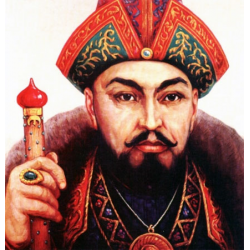
Personality, covered with fame and legends
An image of Ablai Khan is shrouded in a mythical aura. However, like many other national idols, including Abu Nasr al-Farabi, Khoja Akhmet Yassawi, Baydibek, Kabanbai batyr. This is understandable: the larger the personality, the more vividly the people color their features, character traits, and the greatness of their actions. First of all, the recorded facts will be presented here.
Ablai (his real name is Abilmansur) was born on May 23, 1711, in Turkestan and died in 1781 near the Arys River in South Kazakhstan. The occupation: The Khan of the entire Kazakh Khanate, recognized by all zhuzes. An origin: the son of Korkem Uali-sultan, the grandson of Abylai khan Kansher, the descendant of Barak-khan (in the 9th generation). Ablai Khan's ancestors had descended from Genghis Khan's son Jochi. By the way, if anyone paid attention to the word “Wali” in the father's name, he will immediately understand that Shokan Ualikhanov, a Kazakh scientist and educator, is a direct descendant of Abylai Khan, more precisely, a great-grandson.
But even these meager biographical facts, cited on Wikipedia, are questioned by the scientists, like his real name. They write that initially he was not Abilmansur at all – this is just a nickname. From Persian, it translates as “Winner”, “Invincible”. By the way, the name of the great Tamerlane was Abilmansur-Tamerlane. And the real name of Abylai Khan will remain so – Ablai, and if more fully – Ablai-Muhammad-Bapadur Sultan. They say, this is engraved on his personal sultan and later khan`s seal. In favor of this version of the real name, an argument is made that his grandfather was called the same – Ablai, nicknamed Kansher (bloodsucker), given by the enemies for his violent rage in battle. All these discrepancies and scientific investigations only indicate that interest in this person has not faded so far and, it seems, like it will never fade away.
Ablai Khan also had a nickname Sabalak. He has his own history, going back to the difficult khan's childhood. When the future great commander was 12 years old, there was a struggle with the Dzungars, and his father, Sultan Uali, died in this war. The boy became an orphan. According to the folk legends, the servant Oraz carried the boy out of the city engulfed in fire on his back. And, they went to Turkestan to ask for the patronage from noble relatives. But they were refused. The teenager had to wander around the steppe, carefully hiding his noble origin. Ablai endured all sorts of hardships, got a job on “Dirty” work for rich people. So, according to the legend, he grazed the camels of the famous Tole bi, and after that he was a shepherd at the rich landowner Dauletkeldy. He looked terrible at that time: dressed in rags, skinny, unkempt. Therefore, they called him Sabalak, that is, “Shaggy”, “Beggar”. But despite this, according to the testimony of contemporaries, and most likely, in accordance with folk myth-making, he always behaved with great dignity! I never sat on the bare ground, ate from a common dish, drank from a dirty cup, and never asked for anything. The owner, having noticed such an unusual style of behavior for the “Hicks”, once presented his worker with the best horse in the herd – the fire-tailed Chalkuyruk. And a year later, Sabalak decided to become a warrior. He went to the famous Bogenbai batyr, and with the permission of Tole bi, he took him into reconnaissance, and then completely brought him closer to him, making him a squire. A career was dizzying at that time: from a shepherd, a herder to an outstanding warrior-commander.
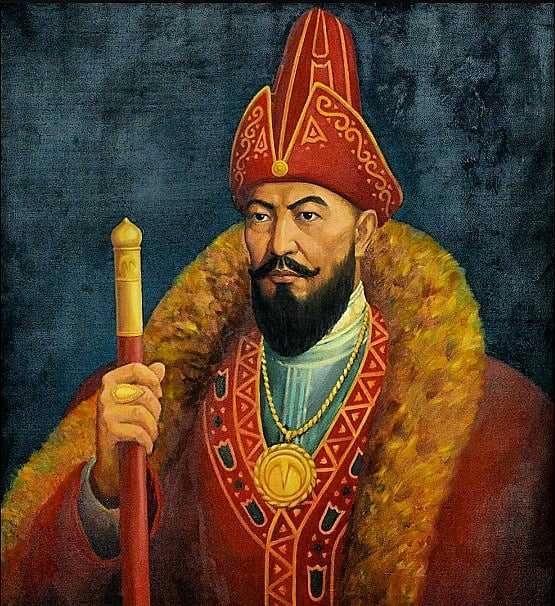
On the road to greatness
When I read about the difficult youth of the future ruler of the Kazakh Khanate, I remembered: but the same mythologized facts of the biography were attributed to the great al-Farabi! And before his triumph in life, he wandered across the Asian desert too. And once he worked as a garden watchman for an Arab caliph too. Probably, the descendants simply tend to endow their heroes with living human traits and experiences, such as: deprivation, suffering, overcoming all disasters, and in the end – a fabulous apotheosis of wealth and glory.
However, the modern scientists also consider this part of Ablai Khan's life as fictional, in order to put it mildly. And, they give relevant arguments and facts. For example, there is documentary evidence that, being an orphan, Ablai still did not remain without patronage and a roof over his head. He was first taken under his wing by his own uncle Kayip Khan, then Sameke Khan, and then Abdulmambet, Khan of the Middle Zhen. Due to the high khan's tutelage, Ablai received a comprehensive aristocratic upbringing and education, was trained in the art of war and hand-to-hand combat, was known as a well-aimed marksman, orator and subtle diplomat. The scientists cite a protocol of negotiations, where almost verbatim, down to the smallest details, describes the course of Abdulmambet's meeting with the Russian governor, where Ablai was also present. So the officials were very surprised by negotiating abilities of the young diplomat, his persistence and perseverance in defending the interests of the state. It was clear that the young man had a great future. In addition, Ablai showed a true natural intelligence, and respect for other people's customs and knowledge of diplomatic protocol during the negotiations. So, for example, he apologized to the guests for sitting in a headdress, explaining that it was not customary for the Kazakhs to take it off. The Russian side was fascinated by such an emphasized delicacy, unexpected for a representative of the steppe.
Ablai was one of those few state nobles who covered themselves with the laurels of personal victories over the enemy first, before reaching the power. Therefore, there is no doubt about his legendary battle with the Dzungarian batyr, whom he inflicted a crushing defeat. He was only 19 years old then. Here are how historians describe it: “From the early morning near Itishpes, Alakol, two troops were lined up: The Dzungarian one was under the yellow-black banner and the Kazakh one with a white horsetail and the wolf's head. But the battle did not start immediately. A duel of batyrs was traditionally held in front of it. The son of the hutaiji Galdan Tseren Sharysh left the Dzungars. He is described as a powerful man of gigantic stature, a famous brave man. He was all clad in armor. I drove menacingly into the middle of the river and froze in anticipation of the enemy.
The confusion began among the Kazakh army. Nobody dared to fight Sharysh. The Dzungars laughed loudly at the same time. And then, the legend tells, the squire Bogenbai batyr, nicknamed Sabalak, suddenly left the back ranks of the Kazakh army. Throwing aside the spear, shield, saber and chain mail, in only one sleeveless jacket, he went boldly towards Sharysh. The Dzungars, looking at the young warrior, began to laugh more than ever, drowning out the sound of the river with their laughter. The Kazakhs did not dare to look at what was happening, so much pity the madman who rode out to meet his death so bravely. “Further I will tell in my own words, for a leisurely epic narration would take all the printed space meted out to me”.
Ablai rode up so close to the enemy that he began to poke a spear at him randomly, but the young man evaded these attacks deftly. And then, seizing the moment, he quickly jumped on the Dzungar Noyon. Both warriors were in the water. Light Sabalak quickly dived out, and Sharysh, under the weight of the iron hung on it, immediately went to the bottom. The inspired Kazakhs immediately went on the attack, and after a short battle the Dzungars were swept away and defeated. The result of the battle was victorious for Ablai himself. The sources write that after this decisive battle, Abilmambet Khan embraced Ablai and revealed his secret to the army: “Once I heard that the only son was left of Sultan Uali, so here he is in front of you. If you approve, then he should be a great khan”. Then 90 representatives of the three zhuzes approved the words of Abilmambet, but Ablai was not immediately given control over the country. It happened only in 1743, when he was raised on the white felt mat in Turkestan and was crowned the Khanate of the Middle Zhuz.
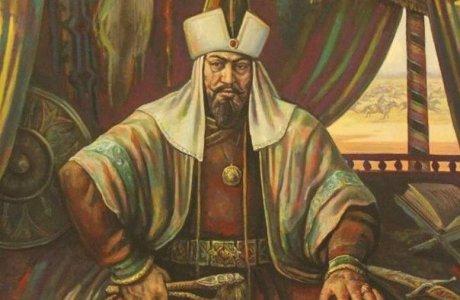
Between the two empires
After the death of Abilmambet Khan in 1771, the power was to be inherited by one of his younger brothers or son Abilpeiz, but the sultans and heads of clans at the congress almost elected Ablai unanimously as the supreme khan. This was the strength of his authority. Since then, he has taken under his rule most of the districts of all three zhuzes.
The position of the Kazakh Khanate, gripped in the grip of two empires – the Russian and the Qing – was complex and ambiguous. In order not to be crushed by these “Sharks of imperialism”, Ablai Khan had to choose a very cautious, wise, and somewhere sly policy. And, he chose a policy, as they say now, multi-vector. Yes, it was necessary to maneuver and dodge for the sake of the main goal – to ensure the independence of the khanate, and preferably in a peaceful way. Whatever he did: made a temporary alliance with Dzungaria, accepted Chinese citizenship in Beijing, swore allegiance to Russia, contacting both Catherine the Great and the rebel Emelyan Pugachev at the same time. However, he managed not to lose his face. So, for example, in 1765 he concluded a treaty with Russia, but did not accept as a legal decision of the tsarist government to grant him the title of Great Khan. Ablai did not even come to the solemn ceremony, where, in accordance with the script, he was supposed to be presented with the appropriate act, fur coat and a saber. He considered it in order to beneath his dignity, because he was convinced that it was not Russia that had elected him as the Khan, but his own people.
After his death, the ashes of Ablai Khan were delivered with honors to Turkestan and buried in the mausoleum of Khoja Akhmet Yassawi. During his lifetime, he was numbered among the host of saints. He left 70 children (30 boys and 40 girls) from 12 wives. The eldest son Uali became the heir to the khan throne. But his main legacy is the memory of the Kazakh people, in which he remained as a ruler who gave all his strength to strengthen and preserve the Kazakh statehood. And it's worth a lot.
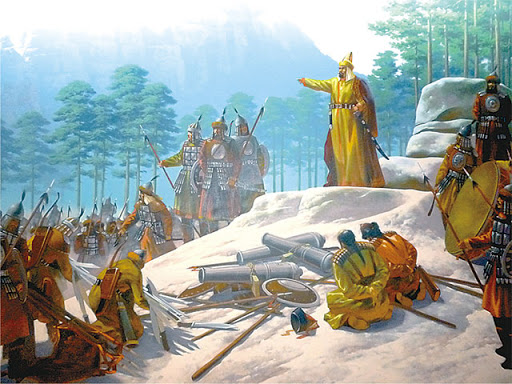
Kazakh Ablai Khan University of International Relations and World Languages
Ablai pursued a policy adapted to the geopolitical situation of Kazakhstan, located between the Russian and Chinese empires. The direct Kazakh-Chinese relations began to form in the time of Ablai, in the second half of the XVIII century. This was due to the number of factors, including the internal and external situation in the state of Dzungaria. The Qing dynasty of China (1644-1912) was constantly waging wars with the Dzungars, initially trying to attract Kazakhs to its side in this struggle. The events that took place in Dzungaria in the middle of the XVIII century provided good opportunities for the implementation of the conquest policy of the Manchu-Chinese Qing Empire. After the death of Galdan Tseren, the strongest ruler of the Dzungars, a dispute over the throne began among his heirs in 1745. The candidates for the throne seek support not only from domestic tribes, but also from foreign countries. At this time, a number of Kazakh rulers, especially Sultan Abylai, were actively involved in the internal affairs of Dzungaria. They tried to take advantage of the unstable situation in the neighboring country in order to seize the eastern regions, that were under the control of the Dzungars. The ancestral settlements of Ablai, a famous sultan of the Middle Zhuz, were located in Central Kazakhstan. However, trying to spread its power to the eastern and southeastern regions, these migration zones decided on the internal and external affairs of the Dzungar tribes bordering on the eastern part of Kazakhstan. In this policy, Ablai supports the candidates for the Dzungar throne – Davatsi (Dauashi) and his ally Amirsana. In order to increase his influence in the internal affairs of the Oirat, Sultan Ablai gave refuge to Davatsi and Amirsana in 1751, who had fled from Dzungaria after being defeated by another candidate for the power, Lama Dorji. After the assassination of his common rival Lama Dorji, Amirsana suddenly confronts Davatsi, in which Ablai supports the former case. Not only the Kazakh feudal lords led by Ablai, but also the representatives of the Qing Empire in Mongolia were closely monitoring the events in Dzungaria and their relations with Central Asian countries. In 1754, Amirsana was defeated by Davaci and fled to China to seek help from the Qing government. Amirsana's arrival is a good reason for the Chinese government to invade Dzungaria and conquer them once and for all. In the summer of 1754, Emperor Qianlong said, “Amirsana is a very important person. If he comes to us, it will be a great benefit for the trip next year”. The emperor knew from the beginning the ultimate purpose of Amirsana's arrival. His goal was not to obey the Chinese, but to gain their support in order to gain power. In 1754, the Qing Empire invaded Dzungaria and planned to use the Amirsana for this purpose. Through the political events in Dzungaria, the Chinese Empire had the closer ties with the Kazakh Khanate and one of its strongest rulers, Sultan Abylai. The Chinese had heard from Amirsana and his supporters that the Kazakh rulers were also helping them. In addition, they were aware of the actions of Kazakh troops in Dzungaria from their governors in northern Mongolia. In the territory of the Middle Zhuz, Amirsana's supporters led Kazakh troops and attacked the tribes of his opponents. Amirsana's close relative was among them, Batma-Tseren. Amirsana's special attention to the Kazakhs, the lack of detailed information about the strength of the Kazakh zhuzs, led the Qing rulers to pay special attention to the position of the Kazakhs in preparation for the expedition to Dzungaria. The Qing government did not want a large centralized state in the neighboring territories. Therefore, it opposed the accession of Amirsana to the throne of the whole Oirat, because his plans were against the interests of the Chinese. The 200,000 troops of the Qing Empire, sent in two directions to Dzungaria, left Barkol and Uliastai and joined to the Buratala valley in April. According to the reports, the Qing army was withdrawn with the intention of “Completely destroying the Dzungars in the Tien Shan region and leaving no traces behind”. Before going to the campaign in Dzungaria, the Chinese government thought a bit about the position of the Kazakhs during the campaign. The issue of their use was also on the agenda. In June 1755, the Qing army captured Davatsi at Mongolkure on the Ili River and destroyed the Dzungar Khanate. The surviving inhabitants of the Dzungar ulus were divided into four taishis, who ruled from above. The Qing government will also introduce a system of governance appointed by the Qing government. This showed that Amirsana's goal of becoming an entire Dzungar khan had not been achieved yet. Therefore, he secretly began preparations against the Qing dynasty. He sent the troops to the underground Kazakhs, made contacts and gathered troops along the Ili. He explains his actions to the Chinese as a measure to protect them from the Kazakhs. However, the Qing dynasty, knowing that the Kazakhs had no intention of attacking them, did not believe him. Therefore, in June 1755, the Qing government sent the above-mentioned official embassy to the Sultan's Ablai Horde to establish direct contact with the Kazakhs.
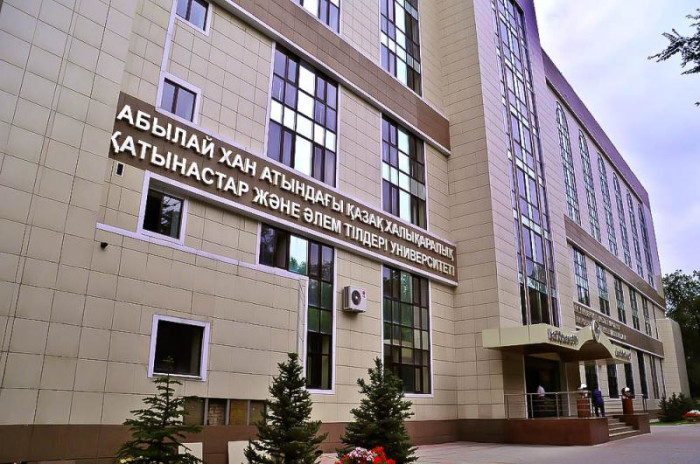
Ablai Khan Avenue in Almaty
The Chinese side told the embassy: “When you go to the Kazakh border, you should not quarrel. But be careful. Even if the armies of that country attack you, you must repel them. If they do not obey, you can arrest and destroy them”. In fact, the Kazakhs were not attacked on the way to the embassy headed by Shundena. They returned safely to the reception of Sultan Ablai. An embassy was to inform the Kazakhs that the Dzungar Khanate was part of the Chinese Empire. In this regard, the Kazakhs are required to stop interfering in the affairs of the Oirats. Ablai welcomed warmly the ambassador of the Qing dynasty. In the East, he realized that it was more beneficial to establish contact with the Qing dynasty than with Amirsana. Ablai also sent his ambassadors, led by Bulebay, along with the Qing envoys to their military line along the Ili River to reconnaissance. This was the beginning of official relations between the Kazakhs and the Qing government. A royal decree sent to the Orenburg administration on October 4, 1779, provided for measures to “Find a man who could compete with Ablai in order to weaken his influence in the Horde”. The Russian government was deeply concerned about China's military actions in Dzungaria and neighboring Kazakh lands. On May 19, 1758, Major-General Tevkelev and collegiate adviser P. Rychkov made a statement to the Russian Foreign Affairs Board, in connection with the actions of the Chinese Empire towards the Kazakhs. They considered the intention of the Chinese army from Siberia to attack the Russian border there in which case it is possible to send Kazakhs and several thousand Meshchers and Bashkirs to the Siberian frontiers against them. In the middle of the XVIII century there were major geopolitical events in Central Asia with the direct participation of the Kazakhs, especially Sultan Abylai. Ablai's policies and campaigns were important for the Kazakh people, who began to be influenced by neighboring countries. As a result of the sultan's campaigns, the Dzungarian state, that had been a troubled and dangerous neighbor for the Kazakhs for the centuries, ceased to exist. His military actions not only expanded the Kazakh territory in the east, but also laid the foundation for the diplomatic relations with China. The ardent leader of the liberation struggle Abylai Khan's personality and wisdom were reflected in the poems of Bukhar, Umbetey, Shadi Tore Zhangiruly, and also in the works of Ilyas Esenberlin, Abish Kekilbayev, Kabdesh Zhumadilov and other poets and writers. Their life, domestic and foreign policy have attracted the attention of domestic and foreign scholars. An inauguration of Abylai Khan has been going on since the independence of our country. It is not a one-day affair. The exploration of Ablai in the national context and the transfer of his name to the universities and the erection of monuments to him are still carried out too. The President Nursultan Nazarbayev said: “Kneeling with the heroes, he showed the great examples of heroism, and the people were moved as well. Heroic deeds of Abylai Khan became one of the golden pillars of the revival of the Kazakh spirit in those difficult times.

(The pictures were taken from the open sources)
 Subscribe to our Telegram channel and be the first to know the news!
Subscribe to our Telegram channel and be the first to know the news!